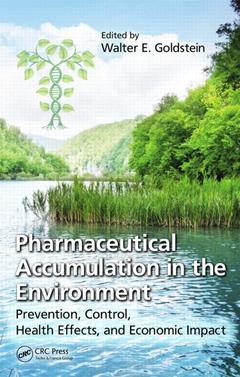Pharmaceutical Accumulation in the Environment Prevention, Control, Health Effects, and Economic Impact
Coordonnateur : Goldstein Walter E.

A Proactive Approach to Improving and Protecting the Environment
The accumulation of pharmaceuticals in the environment is a growing concern, the magnitude of which has not been determined, yet cannot be ignored. Touting the benefits of research and discovery as it relates to a pharmaceutical presence in the environment, Pharmaceutical Accumulation in the Environment: Prevention, Control, Health Effects, and Economic Impact explores ways to effectively minimize the harmful impact of environmental contaminants. It considers current practice in the field, provides a historical reference, and presents effective methods for detecting and containing low levels of environmental contaminants. It also offers practical suggestions for mobilizing private and public resources.
Discusses Health Impacts and Risks to Humans and Other Living Species
The contributors of this work consider important environmental contaminants that include pharmaceuticals, personal care products, and special products, such as contrast agents and illicit drugs. This book describes current health impact concerns, methods for assessing risk, and lessening the negative impact on health through research and analysis. It examines the costs of wastewater treatment, and considers ways to potentially reduce the effect of environmental contaminants in treated water and in the soil. It looks at what may be done about contaminated soil and landfills, addresses the costs of contaminant elimination, and suggests ways to get rid of contaminants sensibly and consistently. It also includes case histories and chapters authored by specialists who are experts in their fields.
Developed as a reference for professionals and senior undergraduate and graduate students in environmental science/ecotoxicology, the text proposes advancements and applications that can help control pharmaceutical accumulation and improve the environment. It serves as a resource for those in the pharmaceutical industries, personal care product industries, and related areas; scientists and researchers in related areas; as well as environmental protection agencies, physicians, and medical personnel.
Introduction. An Insight into the Discovery of the Contamination of the Environment and Drinking Water by Pharmaceuticals. Presence and Fate of Pharmaceuticals in the Environment and in Drinking Water. Occurrence, Effects, and Methods for Antibiotics and Illicit Drugs in the Environment. Detection of Pharmaceuticals in the Environment: History of Use as a Forensic Tool. Health Impact of Pharmaceuticals in the Environment and in Drinking Water: Potential for Human and Environmental Risk. Health Impact of Pharmaceuticals in the Environment and in Drinking Water: Analysis and Research Needs. Effect of Antibiotics on Biological Wastewater Treatment Processes. Wastewater Pharmaceuticals Minimization: Analysis of Opportunities and Costs. Conclusions and Recommendations, Research Opportunities, and Implementation of Measures to Control Environmental Pharmaceuticals.
Walter E. Goldstein, PhD, PE, founded Goldstein Consulting Company in 1994. He founded and developed a forensic sciences DNA profiling laboratory at the University of Nevada–Las Vegas from 2003 to 2008. It was shortly after this that his first book for Taylor & Francis was published,Sick Building Syndrome and Related Illness: Prevention and Remediation of Mold Contamination. Dr. Goldstein holds a BS in chemical engineering from the Illinois Institute of Technology (1961), and an MS(1971) and PhD in chemical engineering from the University of Notre Dame (1973). He also holds an MBA from Michigan State University (1968).
Date de parution : 06-2014
15.6x23.4 cm
Thème de Pharmaceutical Accumulation in the Environment :
Mots-clés :
Personal Care Products; Clofibric Acid; Contamination of the Environment; Activated Sludge; Contamination of Drinking Water; Pharmaceutical Compounds; Pharmaceuticals; Pharmaceutical Contamination; Antibiotics; Wastewater Treatment; Illicit Drugs; Human Pharmaceuticals; Water Analysis; Ta Te; Biological Wastewater Treatment Processes; Pharmaceutical Concentrations; AUC; Area Under The Curve; Biomass Particle; Wastewater Treatment Plant Effluents; Seed Tank; Environmental Contaminant Exposure; HQ; Pharmaceutical Residues; Activated Sludge Floc; Te Ta; Trace Level Concentrations; Im En; Pharmaceutical Metabolite; Endocrine Disrupting Compounds; Waste Treatment Plant; Suspended Solids



